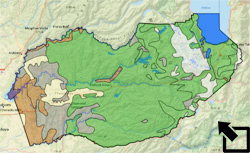Ecologists at the University of California at Davis are studying changes in vegetative patterns in the Sierra Nevada foothills and mountains using data going back to the Wieslander studies of the 1930s and similar inventories from the last few decades.1 They have noticed a number of changes in the area's vegetation both in type and extent - changes that you will be able to examine in the following activities. You can preview the general pattern of change in the two most predominate types of vegetation in El Dorado County- Ponderosa pine and woodland oaks - in this set of slides. As you examine the slides, see what general changes in the locations of these two types of vegetation you notice.

Click to open map |
Let's look more closely. Open the El Dorado: Vegetation map and zoom in on El Dorado County.
Click open each vegetation layer in succession starting with 1934 and ending in 2002. You will be able to see the overall change in the county's vegetation over this time period. Notice that the map legend for 1934 layer is somewhat different from the other three years.
To Start You Thinking -
1) In order to focus your attention on a particular type of vegetation you can filter the data by Gridcode. Look specifically at fir and pine forests (codes 6 and 7 in 1934; 8 thereafter). Describe the location of the western boundary of the evergreen forest in terms of nearby towns and longitude. Do the same for each of the other years. Describe your conclusions.
The UC Davis ecologists claim that there has been a shift in vegetation pattern up the slope of the Sierras and to the east. In the Evolving Patterns worksheet you will begin an examination of this conclusion by focusing on changes in El Dorado County generally and in one specific location within the county. You will also explore the possibility that climate change has contributed to this shift along with changes in land use over the last half century.